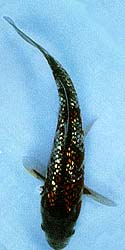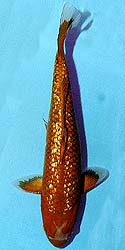"Text Book Imperfection" Tradition dictates many of the traits that are sought after in the pursuit of the "ideal" koi. We are told, for example, that a Showa should have strong black and pristine white accented with an balanced red pattern. Preferably, all three colors should be present on the head. It should have strong moto guro (black at the base of the pectoral fins, at the mouth or nose, and at the base of the tail). It should have menware, a diagonal black marking extending from the forehead to the nose. In the absence of menware, a V shaped black marking behind the head known as hachiware, is desirable. The red should be deep and rich in color, free from black specks, and the edges of the red should be crisp and clean. When the black overlays the red, it is referred to as kasane sumi (layered black), and is scorned as being "unrefined". In this age of instant and abundant information, it is easy to forget that these are merely guidelines intended to assist us in our appreciation of koi. In spending all our efforts searching for the prefect koi, we can sometimes loose sight of what is really important. Regardless of what the judges and koi gurus may have to say, beauty is in the eye of the beholder, and this is where the "Unique Koi" comes in.
In the fall of 1995, a barely 6 inch colorful Ginrin caught the attention of Rich and Lisa Street of Gig Harbor, Washington. It had a strange, almost Kanoko (dappled) root beer colored pattern set on a grey background. It's head was completely grey, a condition unflatteringly referred to as bozu** by our Japanese friends. Charmed by this unique koi, and undaunted by it's political incorrectness, Rich and Lisa took it home to add to their ever growing collection of koi. Over the winter and during the following growing season, the Steet's Ginrin underwent an amazing metamorphisis. It was as if a totally different koi had emerged from the depths of the growing pond. Now measuring a little over 12 inches, the root beer colored dappling had changed to burnished gold that covered almost the entire body and head. The only places that remained gray were the tips of the pectoral fins, and an area on the head that reminds the observer of an Yves Saint Laurent motif. As one can imagine, this truly unique koi holds a special place in the hearts of it's owners, and yes, there is life after Gosanke.*** **pronounced bow-zu: Bozu is the Japanese word for priest. It is customary for a Japanese priest to have his or her head shaven, thus the word bozu is used to describe a koi that has no pattern on the head. ***Gosanke: A Japanese term used to collectively describe the "Big Three" (i.e. Kohaku, Sanke and Showa).
BACK TO TOP |
|||||||||
|
|
|||||||||


